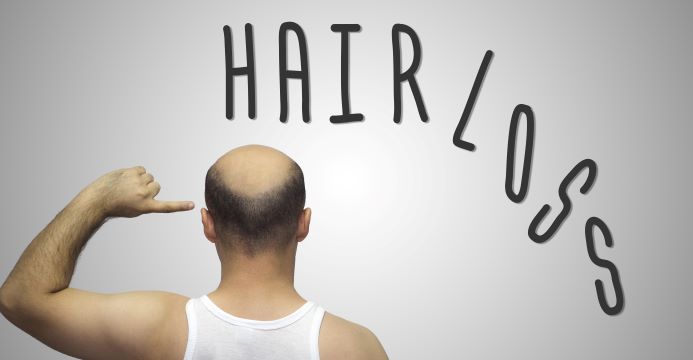August is hair loss awareness month, but if you’re experiencing accelerated hair loss, you’re probably already well aware of it. When you hear the words “hair loss,” you likely imagine traditional male pattern baldness. And while men are more likely to lose their hair, just about anyone is at risk for the various underlying causes that may lead to this common condition. In this blog, Dr. Trisha Patel of U.S. Dermatology Partners Dallas Presbyterian talks about the types of hair loss, common causes, and how your dermatologist can help you combat loss and stimulate hair regrowth.
What Causes Hair Loss?
Also called alopecia, hair loss is actually a very common condition for both men and women. We all naturally shed between 50 and 100 hairs each day. However, when your hair starts to look thin or you notice bald patches, this can be a sign that you are losing too much hair. In most common cases, hair loss is the result of genetics. Certain inherited genes lead to the excess shedding of hair, which typically occurs later in life. However, there are a number of reasons a person might lose their hair including:
- Alopecia areata – An autoimmune disorder that causes smooth, round bald patches on the head and other parts of the body. This condition is oftentimes associated with other autoimmune conditions.
- Cicatricial alopecia – Destroys hair follicles causing scar tissue to form and prevent hair regrowth. There is also a more specific form of this condition called central centrifugal cicatricial alopecia. This form most often impacts women of African descent. As the name may suggest, it begins in the center of the scalp and radiates away from the centralized scarring bald patch.
- Disease – Health conditions that lead to issues with hormone production, thyroid function, and immune system health can all lead to hair loss.
- Illness – Fever and infection, as well as other symptoms of common illnesses, may lead to excessive hair loss in certain people.
- Medications – Cancer treatment with radiation and chemotherapy can often lead to loss of hair. Other medications like blood thinners, birth control, steroids, and even high doses of vitamin A have also been linked to hair loss.
- Hormonal changes – Adolescence, menopause, pregnancy, and other times of great hormonal fluctuation as well as medications that impact hormone levels can cause excessive or accelerated hair loss.
- Stress and mental illness – For many people, prolonged stress can cause them to lose their hair. Left untreated, many mental and emotional health conditions seem to be closely linked to generally poor skin and hair health. There is even a condition called trichotillomania that leads people to compulsively pull out their hair.
- Malnutrition – Without the appropriate nutrients, no part of the body will remain healthy and functional for long. It’s no surprise that poor nutrition and disordered eating are often linked to hair loss.
- Haircare – Products used on the hair can lead to bad reactions for some people. Wearing the hair in certain ways can pull at the scalp, causing a condition called traction alopecia.
Who is Affected by Hair Loss?
Men and women over the age of 50 are most likely to experience hair loss, but this condition can impact anyone at any age. Men have the highest rates of traditional (hereditary) hair loss. However, women are much more likely to experience hormonal and trauma-induced hair loss. There are also some uncommon conditions that cause delayed hair development or the loss of hair in children.
Can Hair Loss be Treated?
Like many other conditions, the recommended hair loss treatment will depend in large part on the underlying cause. Before we get started with a treatment plan, your dermatologist will want to ask several questions about your health, any family history of baldness, and other factors that may be contributing to your hair loss. In some cases, seeking treatment to address an underlying cause will improve hair growth. In other cases, such as hair loss following pregnancy, the issue resolves independently.
Once we have a complete picture of your health and potential causes of alopecia, we may recommend a number of treatments, including:
- Biotin supplementation – Vitamin B7 found in small amounts in eggs, milk, and bananas have been shown to aid in hair loss, strengthening follicles and allowing for thicker growth and retentions of hairs.
- Minoxidil – A topical medication available without a prescription that stimulates hair growth. This treatment can be very effective in many types of hair loss by allowing for synchronization of hair growth and less shedding with visible results as early as six months.
- Finasteride – A prescription medication that is taken in pill form and is approved to slow hair loss in men who experience baldness due to overproduction of dihydrotestosterone (DHT).
- Spironolactone – A prescription blood pressure medication that is taken in a pill form and has been shown to be effective in hormonal (female-patterned hair loss).
- Corticosteroid – If loss of hair occurs due to inflammation, corticosteroid topicals and injections can help to reduce this inflammation leading to hair regrowth. This treatment is often recommended for those suffering from alopecia areata.
- Laser treatment – This may include in-office therapies using laser tools and/or at-home options. Today, you can buy brushes, combs, and other laser treatment devices that can be used to stimulate hair regrowth.
- Hair transplant – A surgical procedure where hair follicles from areas of the scalp with good growth are removed and placed in a balding area. New advancements using robots now allow for less scarring, reduced appearance of transplantation, and greater effectiveness. Recommended for male patients.
Nutrafol is a hair wellness supplement designed with advanced science to improve hair growth and thickness.
Are There Any New Treatments Available?
While these traditional therapies are effective for many patients, they can be painful or time-consuming. But, there are some new treatments on the horizon that look promising. According to Dr. Patel, “Traditional hair loss prevention and treatment options can only go so far. Many options offer improved appearance without fixing the underlying cause of hair loss. One new treatment option that may get at the ‘root’ of the problem is platelet-rich plasma therapy. You may have heard it called PRP therapy.”
Platelet-rich plasma (PRP) is part of the blood. Studies indicate that, when separated out from the platelet-poor plasma and red blood cells, PRP can be used to accelerate healing. Ongoing research is being done to determine its efficacy when used in a range of treatments, including hair loss therapy. PRP therapy for hair loss, when available, involves a three-step treatment process that uses your own healthy blood plasmas to heal damaged hair follicles and stimulate regrowth. Here’s how it works:
- Blood is drawn from the body into a centrifuge machine where it is processed.
- The centrifuge separates the blood into platelet-poor plasma, platelet-rich plasma, and red blood cells.
- Then, the PRP is injected directly into the scalp. Studies indicate that this increased blood supply and the nutrients in the PRP combine to stimulate hair regrowth.
How Can U.S. Dermatology Partners Help with Your Hair Loss?
At U.S. Dermatology Partners, we offer a range of hair loss treatments. And, it all starts with a trip to one of our convenient practice locations. It’s easy to find the closest office. Simply complete our online form, and one of our local team members will be in touch to schedule your visit.
Find a location near me
or



